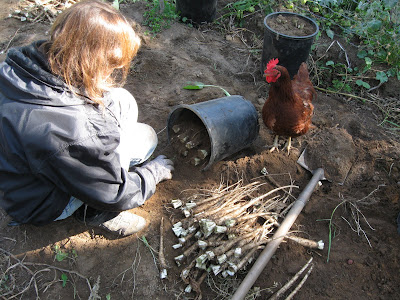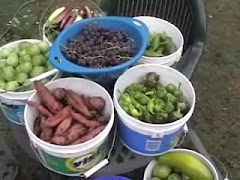
I love growing my own celery. In my opinion there is just no comparing it to the pale nutritionally defunct and often quite poisonous product found in the grocery store. Celery is one of those vegetables that is packed with pesticide residue, just looking at it on the store shelves makes me cringe. My celery will never be as large and crunchy as today's mono-cultured celery but I would be willing to bet, and I hate gambling, that it is by far superior from a nutritional standpoint. Many people might not realize it but home grown celery really is very healthy, packed full of vitamins and minerals. They say of non-organic produce that the good outweighs the bad. Me, I'm only interested in the good, so we grow our own...pristinely of course. Why compromise when it comes to your health?
We start our celery and celeriac indoors around the first of March as the seeds often take a long time to germinate, sometimes almost 3 weeks. A couple weeks after germination we introduce them to the much cooler greenhouse temperatures for about a month and then transplant the seedlings into the garden sometime in May depending upon the weather. They will handle light frosts once established but harsh cold can damage young seedlings. Celery and celeriac seem to do best in full sun, but prefer cooler conditions, and are heavy feeders that need a loose compost rich soil. Ours were much smaller this fall due to the unusual heat we experienced. It was a crazy hot summer, peppers, eggplants, tomatoes all did beyond fantastic while many of the root veggies were a bit on the wimpy side.

Both of these succulents require plenty of water, I will mulch ours with leaves and grass trimmings if I am planting them in a part of the garden that dries out quickly. Enough water makes for fatter more tender stalks and bigger roots in the case of celeriac, after all they are made up of mostly water. Celeriac also produces a tasty albeit smaller and stronger flavored stalk when compared to regular celery but it is still pretty good. If I had to grow just one of these two I would pick celeriac for its roots and stalks.
 Nice size celeriac should be about 4-5" across, ours averaged about 3.5" ...not very big.
Nice size celeriac should be about 4-5" across, ours averaged about 3.5" ...not very big.

This year we grew the heirloom Red Giant and a hybrid celery as the heirloom tends to bolt more easily when subjected to extreme heat or cold for a number of days. The hybrid types seem to hold up better under these conditions but are of little use as far as seed saving goes. Our celeriac was Diamante, an open pollinated variety.
Running low on pots I stuffed around six celery plants into this garden cart for the winter.

For the most part we use these vegetables as a source of winter food and store both of them in the root cellar using them as additions to soups and salads. We carefully dig up and transplant our celery in October before the ground freezes or too harsh a frost sets in. I cut back about 15% of the stalks to compensate for any root damage and continue to make sure the soil does not dry out in storage. You can also cut all of the stalks off and force new growth in winter by bringing the plant into a warmer environment. The more light they receive the greener, and healthier, the stalks become.

Celeriac is treated a little differently as the tops are cut off and the root ball is stored in damp sand just like carrots and beets. Celeriac is a newer addition to our garden and we are still working on becoming familiar with it. Having first tried the roots I was surprised at the nice flavor, having a very subtle but unique celery flavor and a crisp crunch to them.

We left about 2/3 of both of these to overwinter in the garden. Before the ground freezes I will hill leaves and soil around the plants roots and hopefully enjoy early spring stalks before they bolt to seed. I also want seed off of the biennial Diamante celeriac...isn't that a great name for such an ugly root? Our root cellar is starting to look like a jungle with over thirty celery plants hiding down there. Does that make us a bit eccentric? I hope so.
What's in your celery -
http://www.whatsonmyfood.org/food.jsp?food=CE





 Same carrots, over five month later. We love the Lunar and Belgian whites.
Same carrots, over five month later. We love the Lunar and Belgian whites. 





 We string and dry some of our peppers in the greenhouse but never have enough warm dry weather to complete the task.
We string and dry some of our peppers in the greenhouse but never have enough warm dry weather to complete the task.






 This year we grew the heirloom Red Giant and a hybrid celery as the heirloom tends to bolt more easily when subjected to extreme heat or cold for a number of days. The hybrid types seem to hold up better under these conditions but are of little use as far as seed saving goes. Our celeriac was Diamante, an open pollinated variety.
This year we grew the heirloom Red Giant and a hybrid celery as the heirloom tends to bolt more easily when subjected to extreme heat or cold for a number of days. The hybrid types seem to hold up better under these conditions but are of little use as far as seed saving goes. Our celeriac was Diamante, an open pollinated variety.








 Most of the apples we picked are being made into apple sauce as we can't help but bruise them. Between trying to get them out of sometimes 30-40' tall trees and hauling them around on our backs they never do make it home in the best condition. The huge variety of large, crab, green, gold, red, tart, and sweet apples make some of the best sauce. I will happily share this area with the beavers even if it means all the trees will be lost, anything would be better then losing it to another housing development, as we have many of our old stomping grounds. Progress, right?
Most of the apples we picked are being made into apple sauce as we can't help but bruise them. Between trying to get them out of sometimes 30-40' tall trees and hauling them around on our backs they never do make it home in the best condition. The huge variety of large, crab, green, gold, red, tart, and sweet apples make some of the best sauce. I will happily share this area with the beavers even if it means all the trees will be lost, anything would be better then losing it to another housing development, as we have many of our old stomping grounds. Progress, right?

 The pears almost look like little apples, very small and very tart. I'll be planting a few of their seeds this fall.
The pears almost look like little apples, very small and very tart. I'll be planting a few of their seeds this fall.















 We left our potatoes in the ground for several weeks to harden off after most of the vines had died back, this helps to thicken the potato skins which in turn increases the length of time potatoes can be stored. As we pulled our four rows the potatoes were placed in buckets to help keep the different varieties separate until I had a chance to go through and select the best looking ones for next year's seed potatoes.
We left our potatoes in the ground for several weeks to harden off after most of the vines had died back, this helps to thicken the potato skins which in turn increases the length of time potatoes can be stored. As we pulled our four rows the potatoes were placed in buckets to help keep the different varieties separate until I had a chance to go through and select the best looking ones for next year's seed potatoes.






















